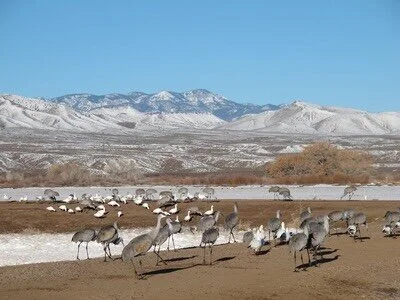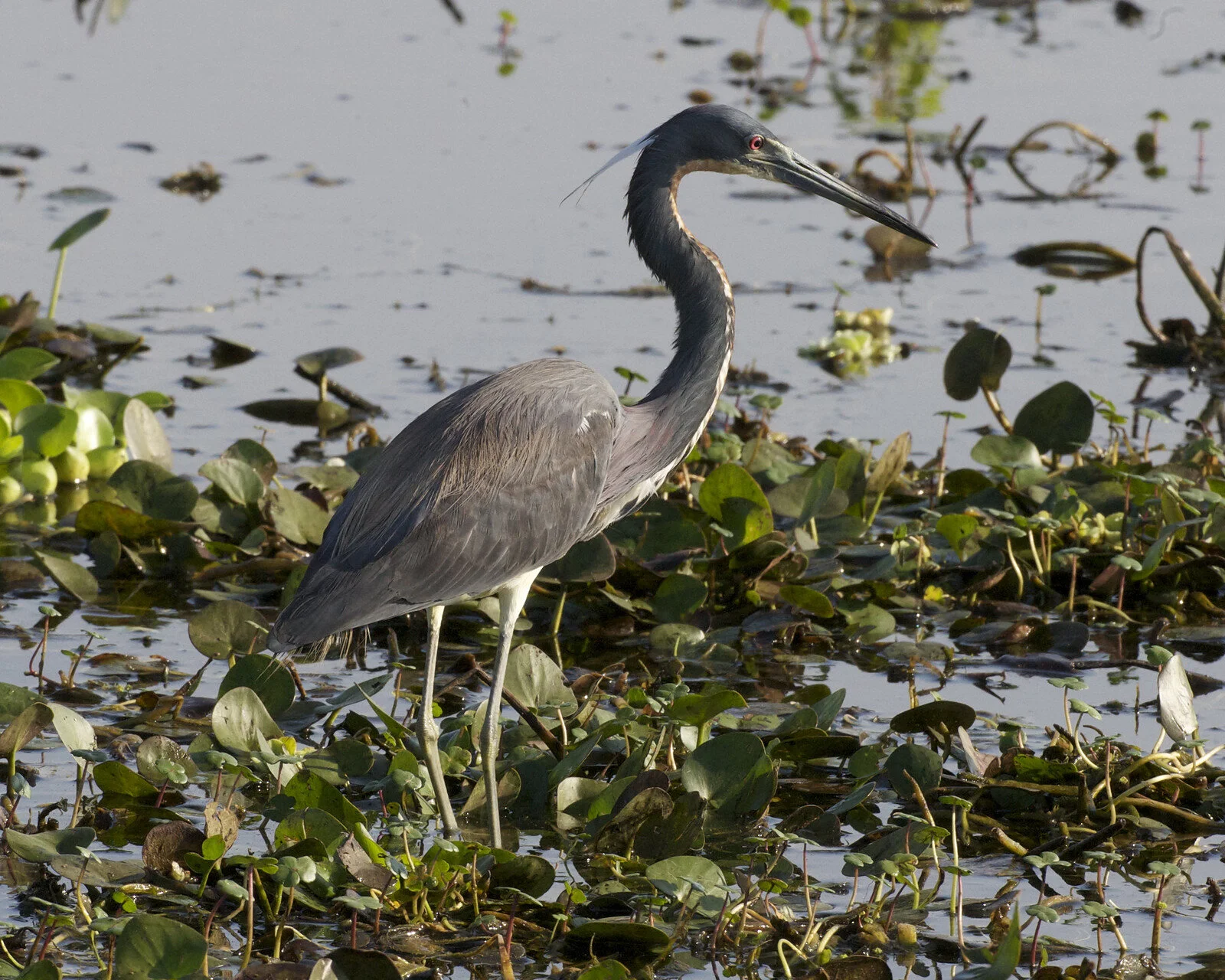The Bosque Is For The Birds
words + photos by Laurie Gilberg Vander Velde
“Maybe I will go to the car and get my tripod,” I said to my husband. We were at the edge of a mostly frozen pond, standing on snowpack, bundled up against the 19 degree cold in the pre-dawn dark. A glimmer of light was starting to show in the sky. We had staked out a spot in the line of tripod-wielding photographers with their mega-humongous lenses We were all waiting for the awakening snow geese and sandhill cranes to perform their morning “fly out.” We were at Bosque del Apache, a National Wildlife Refuge near San Antonio, New Mexico about an hour south of Albuquerque. It’s a place known to many serious bird watchers who throng to the area in the winter to watch thousands and thousands -- and thousands of snow geese and sandhill cranes come and go.
We are not avid birders, nor am I a zealous photographer. How could I be? I love taking pictures and dabble in PhotoShop, but I tote a point-and-shoot camera. It’s top of the line and somewhat flexible, but it’s still a point-and-shoot, and the SLR crowd look at me with some disdain. Much as I would love to use a digital SLR and be able to change lenses, my body just can’t schlepp that much weight. And my husband, despite my batting my eyelids at him, has turned me down flat. It was hard not to be intimidated by the very serious looking phalanx of expensive equipment lined up on tripods waiting for “the moment.”
Our home is now in Santa Fe, so we made the easy two plus hour drive to the Bosque (means “forest” in Spanish) the night before, aiming to get there in late afternoon in hopes of seeing the “fly in.” This is the time during the golden hour before the sun sets and the moments after sunset when tens of thousands of snow geese and sandhill cranes fly in. A foot of snow had closed the refuge a couple of days before, but the plows had sort of cleared the roads. The observation decks were still snow covered. The big problem was that there were limited areas of open, unfrozen water in the ponds, and the birds want to land on open water where they are safer from predators. The helpful folks at the visitors’ center can tell you where the birds landed the night before, but the birds don’t file a flight plan, so we can only guess where they might land tonight.
The light at sunset is especially beautiful, turning the grasses and bare branches golden in the fading light. There was plenty to photograph while waiting. We heard the birds before we saw them, a persistent, but not unpleasant, honking and squawking that carried through the evening air. Of course the birds did not land right in front of us in easy range of my old eyes or my view finder. Instead, they chose more open water just up the road a bit. So we drove up there with the rest of the folks who had gradually abandoned the nice viewing deck.
The birds are impressive in their sheer numbers; they keep coming and coming, thousands of them, crowding in, expanding the growing circle in the open water, honking and squawking as they land. Somehow they find a place to squeeze in among their compatriots. The snow geese are so striking with their brilliant white bodies, wings flapping, black wingtips against the now rosy sky. The sandhill cranes in flight are unmistakable with their long legs behind them, their long necks stretched in front, their huge wingspan and the blaze of red over their eyes. They lower their long legs for the landing; their necks arch as they touch down. They tower over their neighbors as they stand in the water, a dark hulk above the white bodies on the water. All the birds eventually find a space to camp for the night, hopefully safe from predators. The evening light was disappearing, and we were getting pretty cold and hungry. We headed to a local tavern in San Antonio for a much anticipated dinner featuring a green chile cheeseburger, one of New Mexico’s iconic state foods, wondering if the birds would ever stop their chattering and quiet down for the night.
My husband and I are pretty good at sunsets, and the sunsets usually cooperate. We’ve generally had dismal luck with sunrises, but this time we weren’t heading to the Bosque in hopes of some special sunrise. We were driving in the morning darkness to catch the “fly out” of the same birds we’d seen fly in the day before. The birds feed during the day in the fields surrounding the wildlife refuge; they are supported by the wildlife management team as well as by local farmers. They fly back and forth from field to field, usually en masse, but they are not always easy to find when driving around the wildlife refuge. They predictably seek water for their overnight sojourn, and they predictably take off in the early dawn light for their day of foraging for food. This is what we spectators come to see.
Standing in the snow at the edge of the pond as the morning light continued to fill the sky, “our” birds were waking up. Some of their buddies from other flocks squawked their way across the sky, but nothing was happening with our guys. The photographers fussed with their lenses and snapped a few shots. I found the ice and grasses at the edge of the pond of interest and took some shots, but my telephoto lens isn’t long enough to get any good bird details in that light. Some of us wondered out loud when the birds would lift off. Nothing seemed to be happening, and I began to wonder if I needed a tripod. I wondered, then I dismissed the thought. And I wondered again. My husband offered to go to the car and get it and was about to leave...
Suddenly, at some mysterious signal, there was lift off! Thousands of snow geese were air born in a cacophony of honks and squawks. Talk about an astonished group of people! “So fast”, said a Chinese woman in Mandarin which I understood. Shutters clicked as the birds dotted the sky, all of us anxious to seize the moment. And it was truly only a moment! If either of us had gone to the car for the tripod, we would have missed it. I was reminded of every pro-baseball game I ever went to. I’d be busy cracking peanuts or off to the refreshment stand when the roar of the crowd indicated that something wonderful had happened. This time I stayed on my snowy patch and heard the honking of the birds and saw the dramatic “fly out” of the snow geese. Their bigger brethren, the sandhill cranes, departed in their own good time without as much fanfare or noise, but it was a thrill to see them take off and fly off to their feeding ground.
We drove around the loop and happened on a huge number of geese and cranes feeding in the fields. Many birds were close enough for me to take some decent photos. Daylight was complete, but the morning light still had a special glow. We were enthralled with the beautiful sight of the white geese flying against the snow dusted mountains, their black tipped wings beating in the blue sky. The gawky cranes preened and fed on the leavings in the field. More flocks flew in; some flew out. There was more squawking and honking. We lingered for three hours, getting our fill of these beautiful birds and enjoying their calls. In the end, it didn’t matter how big my telephoto lens was. The majesty and sounds of these beautiful birds filled us with joy and wonder. That experience was what we went for, and we were quite content.
Laurie Gilberg Vander Velde and her husband Michael have recently moved to Santa Fe, New Mexico where they are determined to maintain their awe of the natural wonders of their new home state. They intend to continue to behave like “tourists” and explore New Mexico’s beautiful and interesting places.






